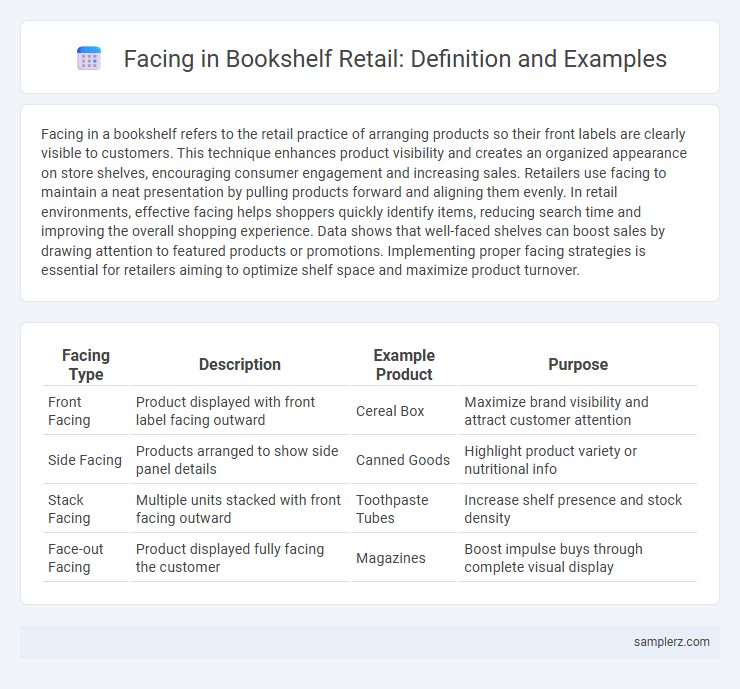Facing in a bookshelf refers to the retail practice of arranging products so their front labels are clearly visible to customers. This technique enhances product visibility and creates an organized appearance on store shelves, encouraging consumer engagement and increasing sales. Retailers use facing to maintain a neat presentation by pulling products forward and aligning them evenly. In retail environments, effective facing helps shoppers quickly identify items, reducing search time and improving the overall shopping experience. Data shows that well-faced shelves can boost sales by drawing attention to featured products or promotions. Implementing proper facing strategies is essential for retailers aiming to optimize shelf space and maximize product turnover.
Table of Comparison
| Facing Type | Description | Example Product | Purpose |
|---|---|---|---|
| Front Facing | Product displayed with front label facing outward | Cereal Box | Maximize brand visibility and attract customer attention |
| Side Facing | Products arranged to show side panel details | Canned Goods | Highlight product variety or nutritional info |
| Stack Facing | Multiple units stacked with front facing outward | Toothpaste Tubes | Increase shelf presence and stock density |
| Face-out Facing | Product displayed fully facing the customer | Magazines | Boost impulse buys through complete visual display |
Understanding Facing in Retail Bookshelves
Facing in retail bookshelves refers to the strategic arrangement of products so that the front of each item is visible to customers, maximizing shelf presence and enhancing product visibility. Proper facing techniques, including consistent alignment and maintaining equal spacing, contribute to an organized appearance that can drive higher sales and improve customer experience. Retailers often use facing counts to determine shelf stock levels, ensuring optimal inventory display and reducing out-of-stock situations.
Types of Facing Techniques for Books
Common types of facing techniques for books in retail include forward-facing, where book covers are fully visible to attract attention, and face-out stacking, which places multiple copies of a title with covers facing forward for maximum impact. Spine-facing is another popular method, displaying only the book spine to maximize shelf capacity while maintaining an organized appearance. Innovative approaches like tiered facing or angled shelves enhance visibility and encourage customer engagement by showcasing select titles prominently.
The Importance of Book Facing in Retail Displays
Book facing in retail displays significantly enhances product visibility by ensuring titles and covers are clearly presented to attract customer attention. Proper facing increases the likelihood of purchase by making it easier for shoppers to find popular or featured books quickly. Optimizing book facing techniques contributes to a well-organized and appealing bookshelf that drives sales and improves overall retail performance.
Front-Facing vs. Spine-Facing Examples
Front-facing displays showcase book covers directly, enhancing visual appeal and increasing impulse purchases by catching shopper attention. Spine-facing arrangements maximize shelf capacity and improve organization, allowing customers to quickly scan titles by author or series. Retailers often balance front-facing and spine-facing methods to optimize both aesthetic presentation and inventory accessibility.
Maximizing Visibility with Creative Book Facing
Creative book facing techniques enhance product visibility by arranging books with covers prominently displayed, capturing customer attention more effectively than traditional spine-out shelving. Utilizing staggered or forward-facing placements aligns with retail psychology, encouraging impulse purchases and increasing overall sales. Strategic use of facing in high-traffic areas leverages visual merchandising principles to maximize shelf impact and improve shopper engagement.
Case Study: Effective Facing in Bookstores
Effective facing in bookstores increases product visibility by organizing books with aligned covers and consistent spacing, driving customer engagement and boosting sales. Case studies reveal that strategic facing techniques create an attractive, easy-to-navigate environment, resulting in enhanced browsing experiences and higher conversion rates. Implementing facing best practices, such as grouping by genre and highlighting bestseller titles, maximizes shelf impact and supports inventory turnover.
How Facing Influences Book Sales
Facing on bookshelves significantly impacts book sales by enhancing product visibility and attracting customer attention to featured titles. Properly faced books create a uniform and organized display, making it easier for shoppers to browse and increasing the likelihood of impulse purchases. Effective facing strategies can boost sales conversion rates by highlighting new releases, bestsellers, and high-margin items in the retail environment.
Common Mistakes in Bookshelf Facing
Common mistakes in bookshelf facing include inconsistent book alignment, which disrupts visual harmony and complicates browsing. Overcrowding shelves reduces visibility of titles and decreases the likelihood of customer engagement. Neglecting to regularly dust and reorganize leads to a cluttered appearance that diminishes the store's overall appeal.
Shelf Arrangement Strategies for Book Retailers
Effective shelf arrangement strategies for book retailers involve front-facing key titles to capture customer attention and boost sales. Organizing books by genre, author popularity, and seasonal themes enhances discoverability and encourages browsing. Implementing vertical and horizontal facings optimizes shelf space while maintaining visual appeal and accessibility.
Tips for Optimizing Facing in Book Displays
Maximize visual appeal by aligning book spines evenly and ensuring titles are clearly visible to attract shoppers. Use front-facing books strategically to highlight new releases or bestsellers and create focal points within the display. Maintain consistent spacing and regularly rotate featured titles to keep the bookshelf fresh and engaging for customers.

example of facing in bookshelf Infographic
 samplerz.com
samplerz.com